|
|
VOC: The First Multinational
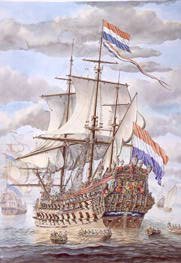 Dutch
expansion to Asia started out as a series of long distance expeditions
financed by several trading companies which were especially set up in
various ports in the Dutch Republic, with the goal of trading for
pepper and spices at their Asian source. However, their intense rivalry
between these companies brought about a steep fall in the price of
spices when these were sold in Holland. In 1601 the raadspensionaris
(advocate) of the Dutch States General, Johan van Oldebarnevelt,
launched the revolutionary idea of merging all existing companies into
one United East India Company (Verenigde Oost-Indische Compagnie
), or the VOC. On March 20, 1602 this enterprise was inaugurated as a
joint-stock company with a founding capital of 6.5 million Dutch
guilders and granted the monopoly on the trade 'East of the Cape of
Good Hope'. Dutch
expansion to Asia started out as a series of long distance expeditions
financed by several trading companies which were especially set up in
various ports in the Dutch Republic, with the goal of trading for
pepper and spices at their Asian source. However, their intense rivalry
between these companies brought about a steep fall in the price of
spices when these were sold in Holland. In 1601 the raadspensionaris
(advocate) of the Dutch States General, Johan van Oldebarnevelt,
launched the revolutionary idea of merging all existing companies into
one United East India Company (Verenigde Oost-Indische Compagnie
), or the VOC. On March 20, 1602 this enterprise was inaugurated as a
joint-stock company with a founding capital of 6.5 million Dutch
guilders and granted the monopoly on the trade 'East of the Cape of
Good Hope'.
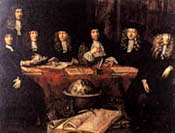 The
VOC was governed by 17 directors, the so-called Heren Zeventien
('the Seventeen Gentlemen'), who represented the directors of the
participating chambers of Amsterdam, Hoorn, Enkhuizen, Rotterdam, Delft
and Zeeland. The Company was authorised to make treaties with Asian
princes in the name of the Dutch Republic, establish forts and
garrisons, appoint governors and preserve law and order in the overseas
territories. It was the young Jan Pieterszoon Coen above all who
provided both the initial planning and execution of strategies that
shaped the trading network of the VOC. The
VOC was governed by 17 directors, the so-called Heren Zeventien
('the Seventeen Gentlemen'), who represented the directors of the
participating chambers of Amsterdam, Hoorn, Enkhuizen, Rotterdam, Delft
and Zeeland. The Company was authorised to make treaties with Asian
princes in the name of the Dutch Republic, establish forts and
garrisons, appoint governors and preserve law and order in the overseas
territories. It was the young Jan Pieterszoon Coen above all who
provided both the initial planning and execution of strategies that
shaped the trading network of the VOC.
| The VOC set new standards in the organisation and
management of overseas trade between Europe and Asia and is thought by
many to be the world's first-ever multi-national company - its
personnel eventually included officers from a wide variety of countries
and its trading network stretched across most of Asia, from Persia Gulf
to the Pacific. However, the Company was not solely a trading venture -
it was also designed to play a role in the Dutch struggle against the
Spanish crown. The States General of the Dutch Republic provided the
Company's ships with the guns and ammunition needed to attack the
Spanish and Portuguese colonies in Asia. The VOC made a vital
contribution by successfully bringing to an end the war of independence
(1568-1648) against the Spanish crown. |
 |
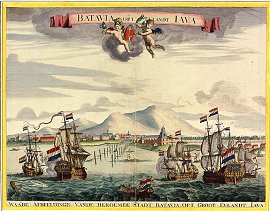 The
Company progressively strung together a vast chain of trade factories
and territorial possessions. After the Napoleonic wars, what came to be
known as the colonial empire of the Netherlands East Indies, arose out
of the ashes of the Company's former possessions in the Indonesian
Archipelago. It is so imprinted in Indonesian memory, that in
colloquial speech, colonial times are often referred to as zaman
kompeni - the age of the Company. The
Company progressively strung together a vast chain of trade factories
and territorial possessions. After the Napoleonic wars, what came to be
known as the colonial empire of the Netherlands East Indies, arose out
of the ashes of the Company's former possessions in the Indonesian
Archipelago. It is so imprinted in Indonesian memory, that in
colloquial speech, colonial times are often referred to as zaman
kompeni - the age of the Company.
VOC strategy began with the building of strategic strongholds
overlooking all strategic shipping routes. It then policed and taxed
the traffic passing by, and sought - by treaty or naval force - the
monopoly on the purchase and sale of specific local goods, such as tin,
cloves, nutmeg and cinnamon. From the beginning, the Dutch made a
relentless effort to control spice-producing Maluku, and then to force
the Spaniards and Portuguese out of key positions elsewhere in Asia. A
monopoly of nutmeg was more or less achieved with the conquest of Banda
in 1621, and of cloves with the Ambon wars of the 1650s, though 'leaks'
were not fully stopped up until the subjugation of Makasar in 1667.
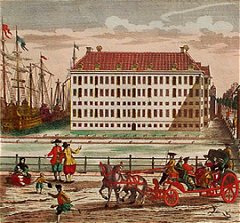 When
Melaka fell to the Dutch after a long siege in 1641, the VOC continued
its vigorous offensive against Portuguese strongholds elsewhere in
Asia. Ceylon and a string of harbours along the Malabar coast were
conquered in the 20 years that followed. By 1690 the VOC was at the
peak of its power in Asia, with a huge Asian trading network connecting
22 factories from Persia in the west to Japan in the east. Its payroll
would mushroom to 24,879 European employees by 1753. Company servants
were by no means all Dutchmen. It has been calculated that around 1770,
no less than 80 per cent of all soldiers and 50 per cent of all sailors
originated from outside the Dutch Republic which, at that time, had a
population of less than two million people. Half of all personnel were
stationed on the VOC's two prize possessions, Java and Ceylon. When
Melaka fell to the Dutch after a long siege in 1641, the VOC continued
its vigorous offensive against Portuguese strongholds elsewhere in
Asia. Ceylon and a string of harbours along the Malabar coast were
conquered in the 20 years that followed. By 1690 the VOC was at the
peak of its power in Asia, with a huge Asian trading network connecting
22 factories from Persia in the west to Japan in the east. Its payroll
would mushroom to 24,879 European employees by 1753. Company servants
were by no means all Dutchmen. It has been calculated that around 1770,
no less than 80 per cent of all soldiers and 50 per cent of all sailors
originated from outside the Dutch Republic which, at that time, had a
population of less than two million people. Half of all personnel were
stationed on the VOC's two prize possessions, Java and Ceylon.
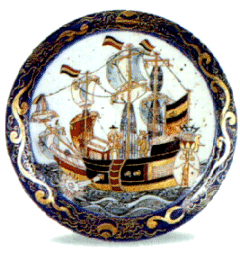 However,
Dutch hegemony at sea in Asia was successfully challenged by the
English East India Company which, unlike the monopolistic VOC, left
room in its Asian operations for private entrepreneurs. Corruption and
lax management also led to the ruin of the VOC at the end of the 18th
century. Virtually bankrupt, the VOC was nationalised in 1795. When its
charter was revoked in 1799 its debt amounted to 219 million guilders -
mostly due to losses suffered during the fourth Anglo-Dutch War
(1780-1784). Almost all home-bound shipping was seized by the English
navy and the VOC were no longer able to repay the costs of fitting out
the outward bound fleets. However,
Dutch hegemony at sea in Asia was successfully challenged by the
English East India Company which, unlike the monopolistic VOC, left
room in its Asian operations for private entrepreneurs. Corruption and
lax management also led to the ruin of the VOC at the end of the 18th
century. Virtually bankrupt, the VOC was nationalised in 1795. When its
charter was revoked in 1799 its debt amounted to 219 million guilders -
mostly due to losses suffered during the fourth Anglo-Dutch War
(1780-1784). Almost all home-bound shipping was seized by the English
navy and the VOC were no longer able to repay the costs of fitting out
the outward bound fleets.
A venerable institution which had annually contributed some
ten per cent of the total Dutch national income, it was now
overburdened by debts and came to an ignominious end.
Write to the author: sabrizain@malaya.org.uk
The
Sejarah Melayu
website is
maintained solely by myself and does not receive any funding
support from any governmental, academic, corporate or other
organizations. If you have found the Sejarah Melayu website useful, any
financial contribution you can make, no matter how small, will be
deeply appreciated and assist greatly in the continued maintenance of
this site.
|
|

